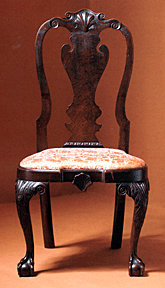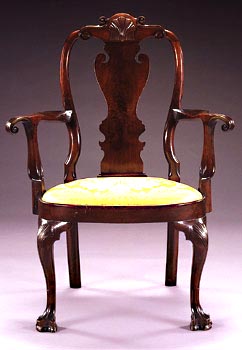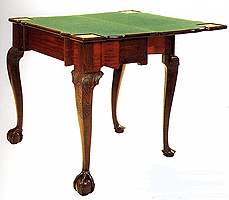The Grace of Queen Anne
by
Bob Brooke
 When the
first English settlers came to America, England was just emerging from
the Middle Ages. Furniture of the time was heavy and cumbersome and
constructed chiefly of oak. By 1700, furniture had become gradually more
plentiful and new forms appeared to fill domestic needs. The Queen Anne
style offered homeowners lighter, graceful, more comfortable furniture,
and the first "period" pieces were born. When the
first English settlers came to America, England was just emerging from
the Middle Ages. Furniture of the time was heavy and cumbersome and
constructed chiefly of oak. By 1700, furniture had become gradually more
plentiful and new forms appeared to fill domestic needs. The Queen Anne
style offered homeowners lighter, graceful, more comfortable furniture,
and the first "period" pieces were born.
Political events, economics (including prosperity at
home and trade with other countries), and the freedom to travel from one
country to another influenced the styles of furniture as well as the
amount considered essential in a home. Every so often, also, a great
furniture designer who introduced new and different-looking pieces
established a style and set a period. Between 1700 and 1800, five
distinctly different furniture styles prevailed in England and America.
The names attached to these styles or periods were sometimes those of
the reigning monarchs, sometimes of a furniture designer. The Queen Anne
style was, of course, named after Queen Anne of England. Though the
style had become popular in England by 1705, it took another 20 years
for it to become popular in America.
 Queen Anne furniture was lighter in appearance and
much more graceful looking than the ponderous 17th-century pieces.
Furniture remained functional, however, and also became comfortable.
Lines were simple, with emphasis on the curvilinear. The single most
important decoration of Queen Anne furniture was the carved cockle or
scallop shell. Often, one large shell was carved on the slant top of a
desk or on the front of a highboy, lowboy, or chest. A smaller shell
sometimes was carved on the knee of a leg and-with or without carving on
the legs-to top the splat of a chair or daybed. The shell motif
emphasized the curvilinear element. On some pieces, this carved motif is
more clearly recognizable as a fan or a sunburst. Queen Anne furniture was lighter in appearance and
much more graceful looking than the ponderous 17th-century pieces.
Furniture remained functional, however, and also became comfortable.
Lines were simple, with emphasis on the curvilinear. The single most
important decoration of Queen Anne furniture was the carved cockle or
scallop shell. Often, one large shell was carved on the slant top of a
desk or on the front of a highboy, lowboy, or chest. A smaller shell
sometimes was carved on the knee of a leg and-with or without carving on
the legs-to top the splat of a chair or daybed. The shell motif
emphasized the curvilinear element. On some pieces, this carved motif is
more clearly recognizable as a fan or a sunburst.
Cabinetmakers replaced the straight, turned legs on
chairs, tables, and cupboards, with more graceful, curving ones called cabriole--that is, the leg had an out-curved knee and an incurved ankle.
Feet were likely to be the simple pad or Dutch foot, occasionally the
drake foot, which was carved with three toes, or the Spanish foot, which
curved gracefully and showed rectangular lines of carving. Stretchers
were omitted or else not particularly noticeable. The kettle or bombe
base, which swelled outward at sides and front, appeared on cupboards
and some other case pieces.
Oak was still widely used in England but walnut became
the preferred wood in both England and America. After walnut, cherry and
maple rather than oak were the choices in this country. Regardless of
the wood, a small amount of Queen Anne furniture was painted white and
gilded.
The drop-leaf table, either oval, round, or
rectangular, replaced the trestle table for dining. Dropping the leaves,
of course, saved space when they weren't in use. Rectangular tables with
marble tops were made for dining rooms because, so far, no one had
thought of making a sideboard.
 Card or gaming tables were another Queen Anne
innovation that continued to be popular for more than a century. By the
mid-18th century in America, it wasn't uncommon for a household to own a
half-dozen or more fine examples of card tables. Each one was well made
of selected hardwood and was handsome, for it was part of the furniture
of the room at all times. No comparison is possible between this style
of table, which has become a classic, and the collapsible bridge (card)
table so common today. Card or gaming tables were another Queen Anne
innovation that continued to be popular for more than a century. By the
mid-18th century in America, it wasn't uncommon for a household to own a
half-dozen or more fine examples of card tables. Each one was well made
of selected hardwood and was handsome, for it was part of the furniture
of the room at all times. No comparison is possible between this style
of table, which has become a classic, and the collapsible bridge (card)
table so common today.
All of these card tables, now bonafide antiques, had
tops consisting of two leaves that were hinged so that one could be
folded on top of the other or be supported against a wall when the table
was not in use. Of the four or occasionally five legs, one was movable
to support the folding leaf when the table was opened to full size. The
square table with a top 36 to 38 inches when opened flat usually had
rounded corners to hold candlesticks to light the gaming. Some tables
also had four oval saucers, one at each player's left, for coins.
Occasionally there was a drawer under the top.
To read
more of my articles, please
visit
my Web site.
<
Back to Antiques Articles
Next Article >
|
